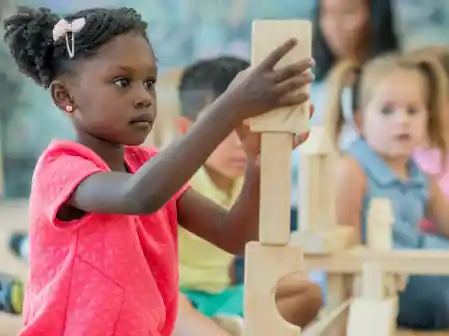Your Classroom as a Compass

Your Classroom as a Compass: Planning for Environments That Children Navigate with Confidence
A well-organized classroom is important for many reasons. At the start of the year, the ability to move through space with ease and assurance is especially important for young children. In a world where so many environments aren’t designed with children in mind, our learning spaces have the opportunity to send a clear message: You belong here. The most functional early childhood settings are planned to unfold and evolve with their learners, making room for ideas, identities, and growing independence.
Clarity Supports Confidence
When the physical environment is easy to understand, children can focus their energy on exploring, engaging, and learning. Clear classroom zones, consistent signage, and well-labeled materials help children know what is available, where things belong, and what is expected. These visual cues reduce the need for adult intervention and increase opportunities for self-direction.
Clarity also plays a role in reducing behaviors that stem from uncertainty. When children are unsure where to go, what to do, or how to clean up, their frustration often shows up in ways that can be misinterpreted as challenging behavior. A predictable environment lowers that barrier. It gives children the structure they need to make meaningful choices, take initiative, and participate more fully in the rhythm of the day. For educators, clear systems create smoother transitions and fewer moments of confusion. Over time, this clarity supports a more collaborative and engaged classroom culture, for children and adults alike.
Simplicity as a Strategy
In the first few weeks of school, it’s common to offer fewer materials, fewer choices, and shorter periods of independent play. Too many choices too soon can be overwhelming. Some children may struggle to make decisions, leading to conflicts or disengagement. Even as we respect children as capable and competent, we know that new settings and routines require extra support.
It’s natural to feel excited about sharing everything your classroom has to offer. You’ve prepared thoughtfully, collected beautiful materials, and imagined how children might use them. As tempting as it is to roll out All Of The Things, a little restraint goes a long way in the beginning.
Simplifying the environment at the start helps avoid decision fatigue and gives children time to internalize routines. Once they know how to return materials, where to find what they need, and how to clean up their space, you can begin to layer in more complexity. That might mean expanding what’s available in interest areas, rotating in new provocations, or introducing new art supplies.
It’s also helpful to remember that children benefit from scaffolding around time, not just materials. Long stretches of open-ended play are important, but they often need to be introduced gradually. Shorter, well-supported activity blocks can help children learn how to stay engaged, solve problems, and collaborate. These skills take time and practice to grow.
Making Routines Visible
Classroom environments are most effective when they support the daily rhythm of the group. Visual schedules, picture cues, and consistent routines help children anticipate what’s next. This kind of predictability reduces anxiety and builds confidence, especially during transitions.
Clean-up time is a good example. What may feel simple to adults often involves many layers for children, especially in a new environment. As teachers, we carry a mental model of what “clean-up” means. Children may be looking at an unfamiliar room filled with materials they’re still getting to know. One child may begin shifting items from one shelf to another without a clear plan. Another just might not be ready to release a new-to-them toy. A third might freeze, unsure where to begin.
Visual tools that are introduced with intention and reviewed regularly can provide children with structure and direction. Photo labels on shelves and baskets help everyone learn where materials belong. A two-step “now/next” visual might show, “First: Tidy up your space / Then: Find a spot the rug.” A daily visual schedule helps children anticipate how many transitions remain before lunch or until they reunite with their family at the end of the day. These supports help create consistency and give children access to what’s expected. When routines are made visible, children are better able to participate with purpose. They can rely on the environment, not just adult direction, to guide their next step.
Orientation includes more than the big transitions. It also shows up in the in-between moments: moving from one center to another, cleaning up after a snack, or hearing the final sentence of a read-aloud. When the environment holds these patterns clearly, children have what they need to move through the day with greater ease.
Arrivals & Reunions
Transitions at the start and end of the day are easier when the environment offers clear visual support. Children arriving at school benefit from cues that help them know what to expect and what to do. A consistent setup near your classroom’s entrance might include labeled cubbies, a family photo wall, and a visual for children’s arrival routines. These thoughtful additions can ease the move from home into the classroom.
Visual supports for beginning and end-of-day routines help remove some of the heavy lifting from transitions that may feel tender. Simple, predictable photo or illustration prompts, such as “hang up your backpack, wash your hands, choose where to start” provide structure that children can practice with their grown-up or teacher, and eventually follow independently. These supports reduce the need for verbal reminders and help children settle into their space more confidently. At pick-up, visual and environmental cues can help children begin to shift from classroom routines to family life. A designated area for end-of-day materials with a “Next Steps” visual can offer gentle structure during this transition as well.
When arrival and departure spaces are designed with children in mind, the flow of the day becomes more predictable and grounded. These supports don’t need to be elaborate. Focus on making them consistent, accessible, and easy to understand.
A Space Children Can Read
At the beginning of the year, the environment speaks before we do. Long before children are fluent in the routines of the classroom, they rely on what they can see, hear, and touch to guide their understanding. That’s why clarity, consistency, and accessibility are so important during the early weeks.
Once you have finalized your back-to-school set-up, take a slow walk through your classroom. Can children tell where things belong? Do they know where to go when they’re finished? Can they access materials independently? These details help children build a mental map of their space and their day. It’s just as important for children and families to see themselves reflected. Do children see their work on display? Can they find photos of the people they love? Are the labels, schedules, and signs representative of the languages and cultures in the room?
A classroom doesn’t need to be perfect. It does need to be readable. This readability supports more than just function. It communicates belonging, intention, and what your classroom community values, long before anyone says a word.
Resources
ADDITIONAL RESOURCES: Becker’s Early Childhood Classroom Visual Resources
INFOGRAPHIC DOWNLOAD: Ready, Set, Explore! Introducing Classroom Materials with Intention
BLOG: Structuring Your Days for Success: Early Childhood Classroom Routines and Rituals
WEBINAR:: Planning for Wonder: Intentionally Preparing Preschool and Pre-K Environments
WEBINAR:: Planning for Joy! Back to School Prep for Infants, Toddlers & Twos
NAEYC Resource: Support You Can See and Feel: Teaching Children with Autism

Christine Murray is an Early Childhood Education Specialist with Becker’s Education Team.
As an educator, coach and leader, Christine is inspired by the curiosity, joy and wonder that children so generously model for us. She earned her M.A. in Innovative Early Childhood Education at the University of Colorado Denver and loves collaborating with and supporting others in the field. Grounded in relationships and guided by empathy, Christine is always learning, connecting and creating.
